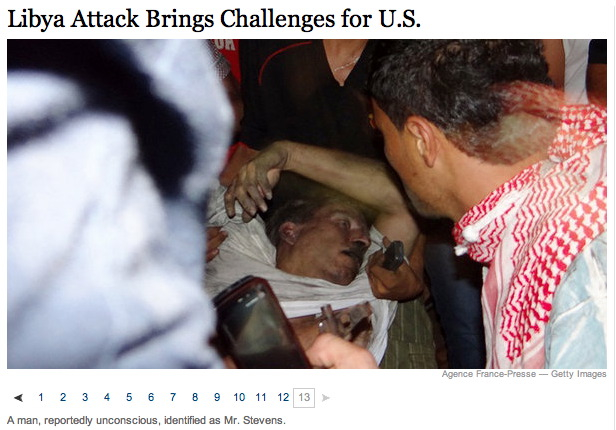30 points
Assigned: Wednesday October 22, 2014
Due: Friday October 31, 2014
The New York Times ran a photo, as part of a photo gallery, showing an image of what is believed to be an unconscious J. Christopher Stevens, the U.S. ambassador, who was killed in an attack on the American Consulate in Benghazi, Libya.
The photo was the last image in a 13 picture photo gallery, part of a story on the attacks and death of the ambassador and three other Americans.

Publishing the photo was very controversial. The newspaper ran a column about their decision, and there are hundreds of comments condemning and defending the paper’s decision to publish:
• Look at the photo gallery. • Read the column about the photo. • Think about the questions at the bottom of this page.•
“I do not support the decision to run images such as the one of the Ambassador. Absolutely disgusting. No consideration for his family. Imagine seeing a photo of your father, mother, son, daughter, being dragged through the streets like that, regardless of why it happened.”
“Was freedom of speech ever intended for this?Â
Issues at the core of our way of life are at stake here. The picture of the Ambassador violated his privacy and dignity.Â
It breaks my heart to read the statistics, let alone see pictures of bodies–and this includes those photographs of the Civil War. I cannot believe that anyone has trouble linking those statistics to human agony. What a sheltered life you have been living, if you have never seen pain.We did not need to be brought to the deathbed of Mr. Stevens.”
“The horror of that photo jerked me immediately into prayer for Mr. Stevens’ family and for all the other victims of this attack and their families.”
“I am offended that The Times thinks that its readers are vile, uneducated, insensitive, mobs of bloodthirsty dimwits. Most of us are
not.”
“I am torn. I think there are pictures that do not deserve to be published because they do strip the dead of their dignity. But this particular picture was not that.Â
Even in death, Mr. Stevens had dignity. And it makes you think that if something like this could happen to such a good man, the world has truly gone mad.
It’s interesting too how showing clearly the manner and mode of a death can be more shameful for the killers than the one murdered.
Isn’t that the one of the reasons behind why Christianity exalts the crucifix, after all? It’s not stripping Jesus of dignity to show him like that, it’s stripping his murders of the ability to be blind to their brutality to one who was so good to them.
Rest in peace, Ambassador Stevens.”
Was the Times right or wrong to publish the photo? Why? Why do you think they published the image?
How did you react to the photograph?
If you were the editor, what would you have done? What factors would you consider?
Email me your thoughts. Be prepared to discuss in class.